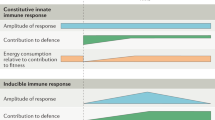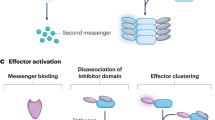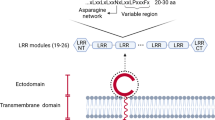Abstract
Effective host defense against microbial infection depends upon prompt recognition of pathogens, activation of immediate containment measures, and ultimately the generation of a specific and definitive adaptive immune response. The innate immune system of the host is responsible for providing constant surveillance against infection; when confronted by pathogens it deploys a series of rapidly acting antimicrobial effectors while simultaneously instructing the adaptive immune system as to the nature and context of the infectious threat. Pathogen recognition and activation of innate immunity is mediated by members of the Toll-like receptor (TLR) family through detection of conserved microbial structures that are absent from the host. Experimental models of infection using TLR-deficient mice, as well as limited human studies, have clearly demonstrated the critical role of TLRs in host defense against most major groups of mammalian pathogens.
This is a preview of subscription content, access via your institution
Access options
Subscribe to this journal
Receive 6 digital issues and online access to articles
$119.00 per year
only $19.83 per issue
Buy this article
- Purchase on Springer Link
- Instant access to full article PDF
Prices may be subject to local taxes which are calculated during checkout
Similar content being viewed by others
References
Medzhitov R, Janeway CA Jr . Innate immunity: the virtues of a nonclonal system of recognition. Cell 1997; 91: 295–298.
Schnare M et al. Toll-like receptors control activation of adaptive immune responses. Nat Immunol 2001; 2: 947–950.
Janeway CA Jr, Medzhitov R . Innate immune recognition. Annu Rev Immunol 2002; 20: 197–216.
Medzhitov R, Preston-Hurlburt P, Janeway CA Jr . A human homologue of the Drosophila Toll protein signals activation of adaptive immunity. Nature 1997; 388: 394–397.
Rock FL et al. A family of human receptors structurally related to Drosophila Toll. Proc Natl Acad Sci USA 1998; 95: 588–593.
Belvin MP, Anderson KV . A conserved signaling pathway: the Drosophila toll-dorsal pathway. Annu Rev Cell Dev Biol 1996; 12: 393–416.
Hashimoto C, Hudson KL, Anderson KV . The Toll gene of Drosophila, required for dorsal–ventral embryonic polarity, appears to encode a transmembrane protein. Cell 1988; 52: 269–279.
Lemaitre B et al. The dorsoventral regulatory gene cassette spatzle/Toll/cactus controls the potent antifungal response in Drosophila adults. Cell 1996; 86: 973–983.
Meng X, Khanuja BS, Ip YT . Toll receptor-mediated Drosophila immune response requires Dif, an NF-kappaB factor. Genes Dev 1999; 13: 792–797.
Lemaitre B et al. A recessive mutation, immune deficiency (imd), defines two distinct control pathways in the Drosophila host defense. Proc Natl Acad Sci U S A 1995; 92: 9465–9469.
Georgel P et al. Drosophila immune deficiency (IMD) is a death domain protein that activates antibacterial defense and can promote apoptosis. Dev Cell 2001; 1: 503–514.
Michel T et al. Drosophila Toll is activated by Gram-positive bacteria through a circulating peptidoglycan recognition protein. Nature 2001; 414: 756–759.
Gottar M et al. The Drosophila immune response against Gram-negative bacteria is mediated by a peptidoglycan recognition protein. Nature 2002; 416: 640–644.
Liu C et al. Peptidoglycan recognition proteins: a novel family of four human innate immunity pattern recognition molecules. J Biol Chem 2001; 276: 34686–34694.
Hoffmann JA, Reichhart JM . Drosophila innate immunity: an evolutionary perspective. Nat Immunol 2002; 3: 121–126.
Qureshi ST et al. Endotoxin-tolerant mice have mutations in Toll-like receptor 4 (Tlr4). J Exp Med 1999; 189: 615–625.
Medzhitov R et al. MyD88 is an adaptor protein in the hToll/IL-1 receptor family signaling pathways. Mol Cell 1998; 2: 253–258.
Medzhitov R . Toll-like receptors and innate immunity. Nat Rev Immunol 2001; 1: 135–145.
Horng T, Barton GM, Medzhitov R . TIRAP: an adapter molecule in the Toll signaling pathway. Nat Immunol 2001; 2: 835–841.
Burns K et al. Tollip, a new component of the IL-1RI pathway, links IRAK to the IL-1 receptor. Nat Cell Biol 2000; 2: 346–351.
Zhang G, Ghosh S . Negative regulation of toll-like receptor-mediated signaling by Tollip. J Biol Chem 2002; 277: 7059–7065.
Bulut Y et al. Cooperation of Toll-like receptor 2 and 6 for cellular activation by soluble tuberculosis factor and Borrelia burgdorferi outer surface protein A lipoprotein: role of Toll-interacting protein and IL-1 receptor signaling molecules in Toll-like receptor 2 signaling. J Immunol 2001; 167: 987–994.
Zarember KA, Godowski PJ . Tissue expression of human Toll-like receptors and differential regulation of Toll-like receptor mRNAs in leukocytes in response to microbes, their products, and cytokines. J Immunol 2002; 168: 554–561.
Rehli M et al. PU.1 and interferon consensus sequence-binding protein regulate the myeloid expression of the human Toll-like receptor 4 gene. J Biol Chem 2000; 275: 9773–9781.
Haehnel V et al. Transcriptional regulation of the human toll-like receptor 2 gene in monocytes and macrophages. J Immunol 2002; 168: 5629–5637.
Lien E, Ingalls RR . Toll-like receptors. Crit Care Med 2002; 30 (Suppl): S1–S11.
Alexopoulou L et al. Recognition of double-stranded RNA and activation of NF-kappaB by Toll-like receptor 3. Nature 2001; 413: 732–738.
Hayashi F et al. The innate immune response to bacterial flagellin is mediated by Toll-like receptor 5. Nature 2001; 410: 1099–1103.
Hemmi H et al. A Toll-like receptor recognizes bacterial DNA. Nature 2000; 408: 740–755.
Schwandner R et al. Peptidoglycan- and lipoteichoic acid-induced cell activation is mediated by toll-like receptor 2. J Biol Chem 1999; 274: 17406–17409.
Means TK et al. The CD14 ligands lipoarabinomannan and lipopolysaccharide differ in their requirement for Toll-like receptors. J Immunol 1999; 163: 6748–6755.
Tsuji S et al. Maturation of human dendritic cells by cell wall skeleton of Mycobacterium bovis bacillus Calmette–Guerin: involvement of toll-like receptors. Infect Immun 2000; 68: 6883–6890.
Campos MA et al. Activation of Toll-like receptor-2 by glycosylphosphatidylinositol anchors from a protozoan parasite. J Immunol 2001; 167: 416–423.
Ouaissi A et al. The Trypanosoma cruzi Tc52-released protein induces human dendritic cell maturation, signals via Toll-like receptor 2, and confers Protection Against Lethal Infection. J Immunol 2002; 168: 6366–6374.
Aliprantis AO et al. Cell activation and apoptosis by bacterial lipoproteins through toll-like receptor-2. Science 1999; 285: 736–739.
Brightbill HD et al. Host defense mechanisms triggered by microbial lipoproteins through toll-like receptors. Science 1999; 285: 732–736.
Sugawara S et al. Monocytic cell activation by nonendotoxic glycoprotein from Prevotella intermedia ATCC 25611 is mediated by toll-like receptor 2. Infect Immun 2001; 69: 4951–4957.
Opitz B et al. Toll-like receptor-2 mediates treponema glycolipid and lipoteichoic acid-induced NF-kappaB translocation. J Biol Chem 2001; 276: 22041–22047.
Werts C et al. Leptospiral lipopolysaccharide activates cells through a TLR2-dependent mechanism. Nat Immunol 2001; 2: 346–352.
Takeuchi O et al. Discrimination of bacterial lipoproteins by Toll-like receptor 6. Int Immunol 2001; 13: 933–940.
Hajjar AM et al. Cutting edge: functional interactions between toll-like receptor (TLR) 2 and TLR1 or TLR6 in response to phenol-soluble modulin. J Immunol 2001; 166: 15–19.
Ozinsky A et al. The repertoire for pattern recognition of pathogens by the innate immune system is defined by cooperation between toll-like receptors. Proc Natl Acad Sci USA 2000; 97: 13766–13771.
Alexopoulou L et al. Hyporesponsiveness to vaccination with Borrelia burgdorferi OspA in humans and in TLR1- and TLR2-deficient mice. Nat Med 2002; 8: 878–884.
Chow JC et al. Toll-like receptor-4 mediates lipopolysaccharide-induced signal transduction. J Biol Chem 1999; 274: 10689–10692.
Hirschfeld M et al. Cutting edge: repurification of lipopolysaccharide eliminates signaling through both human and murine toll-like receptor 2. J Immunol 2000; 165: 618–622.
Kawasaki K et al. Mouse toll-like receptor 4.MD-2 complex mediates lipopolysaccharide-mimetic signal transduction by Taxol. J Biol Chem 2000; 275: 2251–2254.
Kurt-Jones EA et al. Pattern recognition receptors TLR4 and CD14 mediate response to respiratory syncytial virus. Nat Immunol 2000; 1: 398–401.
Shoham S et al. Toll-like receptor 4 mediates intracellular signaling without TNF-alpha release in response to Cryptococcus neoformans polysaccharide capsule. J Immunol 2001; 166: 4620–4626.
Wang JE et al. Involvement of CD14 and toll-like receptors in activation of human monocytes by Aspergillus fumigatus hyphae. Infect Immun 2001; 69: 2402–2406.
Hemmi H et al. Small anti-viral compounds activate immune cells via the TLR7 MyD88-dependent signaling pathway. Nat Immunol 2002; 3: 196–200.
Jurk M et al. Human TLR7 or TLR8 independently confer responsiveness to the antiviral compound R-848. Nat Immunol 2002; 3: 499.
O'Brien AD et al. Genetic control of susceptibility to Salmonella typhimurium in mice: role of the LPS gene. J Immunol 1980; 124: 20–24.
Watson J, Riblet R, Taylor BA . The response of recombinant inbred strains of mice to bacterial lipopolysaccharides. J Immunol 1977; 118: 2088–2093.
Watson J et al. The genetic mapping of a defective LPS response gene in C3H/HeJ mice. J Immunol 1978; 120: 422–424.
Poltorak A et al. Defective LPS signaling in C3H/HeJ and C57BL/10ScCr mice: mutations in Tlr4 gene. Science 1998; 282: 2085–2088.
Bihl F et al. LPS-hyporesponsiveness of mnd mice is associated with a mutation in Toll-like receptor 4. Genes Immun 2001; 2: 56–59.
Woods JP et al. Mouse genetic locus Lps influences susceptibility to Neisseria meningitidis infection. Infect Immun 1988; 56: 1950–1955.
Wang X et al. Toll-like receptor 4 mediates innate immune responses to Haemophilus influenzae infection in mouse lung. J Immunol 2002; 168: 810–815.
Arbour NC et al. TLR4 mutations are associated with endotoxin hyporesponsiveness in humans. Nat Genet 2000; 25: 187–191.
Read RC et al. A functional polymorphism of toll-like receptor 4 is not associated with likelihood or severity of meningococcal disease. J Infect Dis 2001; 184: 640–642.
Lorenz E et al. Relevance of mutations in the TLR4 receptor in patients with Gram-negative septic shock. Arch Intern Med 2002; 162: 1028–1032.
Takeuchi O et al. Differential roles of TLR2 and TLR4 in recognition of Gram-negative and Gram-positive bacterial cell wall components. Immunity 1999; 11: 443–451.
Takeuchi O, Hoshino K, Akira S . Cutting edge: TLR2-deficient and MyD88-deficient mice are highly susceptible to Staphylococcus aureus infection. J Immunol 2000; 165: 5392–5396.
Lorenz E et al. A novel polymorphism in the toll-like receptor 2 gene and its potential association with Staphylococcal infection. Infect Immun 2000; 68: 6398–6401.
Adachi K et al. Plasmodium berghei infection in mice induces liver injury by an IL-12- and toll-like receptor/myeloid differentiation factor 88-dependent mechanism. J Immunol 2001; 167: 5928–5934.
Fortin A, Stevenson MM, Gros P . Complex genetic control of susceptibility to malaria in mice. Genes Immun 2002; 3: 177–186.
Scanga CA et al. Cutting edge: MyD88 is required for resistance to Toxoplasma gondii infection and regulates parasite-induced IL-12 production by dendritic cells. J Immunol 2002; 168: 5997–6001.
Haynes LM et al. Involvement of toll-like receptor 4 in innate immunity to respiratory syncytial virus. J Virol 2001; 75: 10730–10737.
Bowie A et al. A46R and A52R from vaccinia virus are antagonists of host IL-1 and toll-like receptor signaling. Proc Natl Acad Sci USA 2000; 97: 10162–10167.
Wooten RM et al. Toll-like receptor 2 is required for innate, but not acquired, host defense to Borrelia burgdorferi. J Immunol 2002; 168: 348–355.
Lien E et al. Toll-like receptor 2 functions as a pattern recognition receptor for diverse bacterial products. J Biol Chem 1999; 274: 33419–33425.
Means TK et al. Human toll-like receptors mediate cellular activation by Mycobacterium tuberculosis. J Immunol 1999; 163: 3920–3927.
Underhill DM et al. Toll-like receptor-2 mediates mycobacteria-induced proinflammatory signaling in macrophages. Proc Natl Acad Sci USA 1999; 96: 14459–14463.
Kramnik I et al. Genetic control of resistance to experimental infection with virulent Mycobacterium tuberculosis. Proc Natl Acad Sci U S A 2000; 97: 8560–8565.
Mitsos LM et al. Genetic control of susceptibility to infection with Mycobacterium tuberculosis in mice. Genes Immun 2000; 1: 467–477.
Kang TJ, Chae GT . Detection of Toll-like receptor 2 (TLR2) mutation in the lepromatous leprosy patients. FEMS Immunol Med Microbiol 2001; 31: 53–58.
Poltorak A et al. Physical contact between lipopolysaccharide and toll-like receptor 4 revealed by genetic complementation. Proc Natl Acad Sci USA 2000; 97: 2163–2167.
Ohashi K et al. Cutting edge: heat shock protein 60 is a putative endogenous ligand of the toll-like receptor-4 complex. J Immunol 2000; 164: 558–561.
Okamura Y et al. The extra domain A of fibronectin activates Toll-like receptor 4. J Biol Chem 2001; 276: 10229–10233.
Smiley ST, King JA, Hancock WW . Fibrinogen stimulates macrophage chemokine secretion through toll-like receptor 4. J Immunol 2001; 167: 2887–2894.
Termeer C et al. Oligosaccharides of Hyaluronan activate dendritic cells via toll-like receptor 4. J Exp Med 2002; 195: 99–111.
Acknowledgements
The authors thank Markus Schnare for critically reviewing the manuscript.
Author information
Authors and Affiliations
Corresponding author
Rights and permissions
About this article
Cite this article
Qureshi, S., Medzhitov, R. Toll-like receptors and their role in experimental models of microbial infection. Genes Immun 4, 87–94 (2003). https://doi.org/10.1038/sj.gene.6363937
Received:
Revised:
Accepted:
Published:
Issue Date:
DOI: https://doi.org/10.1038/sj.gene.6363937



